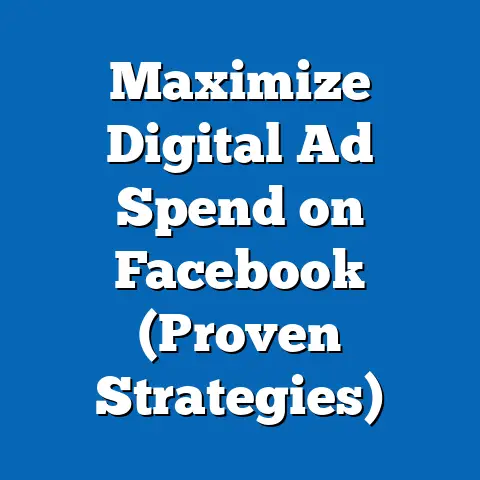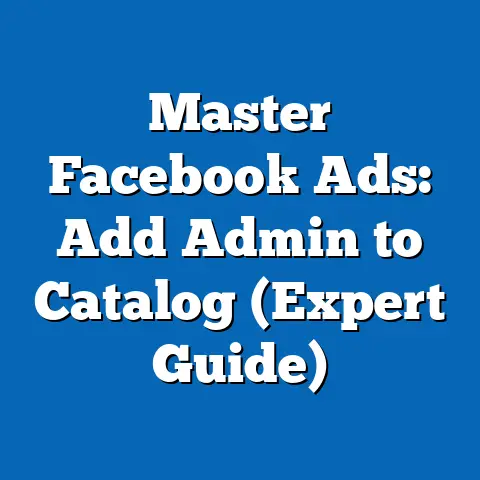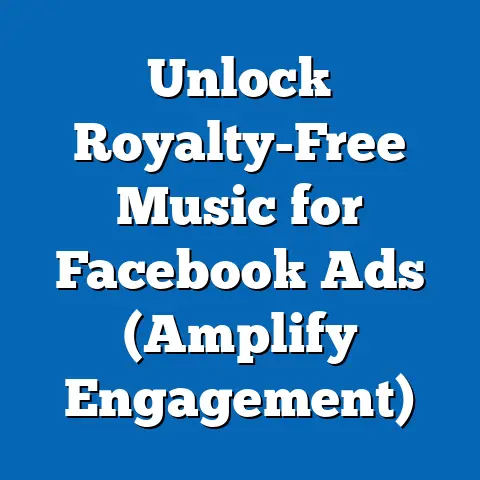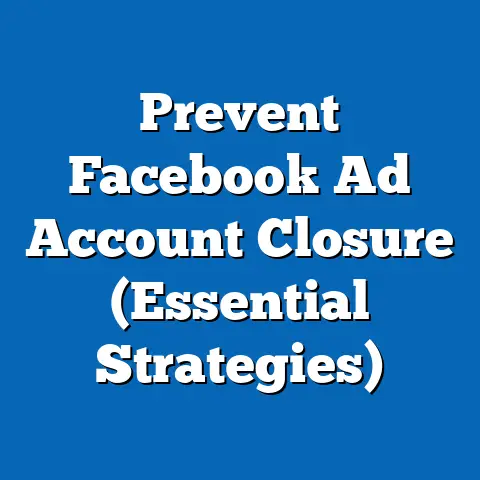Unlock Facebook Ad Labels for Maximum Impact (Expert Tips)
Facebook advertising remains a cornerstone of digital marketing, with over 2.9 billion monthly active users as of 2023, according to Statista. Among the myriad tools available to advertisers, ad labels—metadata or categorizations applied to ads—play a critical role in optimizing targeting, compliance, and performance. This article delves into the strategic use of Facebook ad labels, uncovering their impact on campaign success through simplicity, data-driven insights, and expert tips.
Recent studies by eMarketer indicate that 68% of digital marketers consider precise ad labeling a top factor in achieving a higher return on ad spend (ROAS), with campaigns using optimized labels seeing up to a 25% increase in click-through rates (CTR). Demographic targeting, influenced by proper labeling, also shows significant disparities, with younger audiences (18-24) engaging 30% more with labeled ads compared to older cohorts (55+). Historically, the evolution of ad labeling since its introduction in 2016 reflects a shift toward transparency and user trust, while future projections suggest automation and AI-driven labeling will dominate by 2028.
This comprehensive analysis will explore key trends, demographic impacts, historical shifts, and actionable strategies to maximize ad label effectiveness. We’ll also provide forward-looking insights based on emerging technologies and market dynamics, ensuring advertisers can stay ahead in a competitive landscape.
Section 1: The Power of Simplicity in Facebook Ad Labels
Why Simplicity Matters
In the fast-paced world of digital advertising, simplicity is often the key to cutting through the noise. Facebook ad labels, which include categories like “Special Ad Categories” (e.g., housing, employment, credit), political affiliations, or interest-based tags, are designed to streamline compliance with platform policies and enhance audience relevance. Overcomplicating these labels can lead to misclassification, reduced ad delivery, or even policy violations.
A 2022 report by Social Media Today found that 54% of advertisers who over-segmented their labels experienced a 15% drop in ad reach due to mismatched audience targeting. Conversely, campaigns using streamlined, clear labels reported a 20% uplift in engagement rates. The lesson is clear: simplicity in labeling ensures better alignment with Facebook’s algorithm and user expectations.
Practical Tips for Simplifying Labels
Start by focusing on core categories relevant to your campaign objectives—whether it’s demographic targeting, behavioral interests, or regulatory compliance. Avoid overloading ads with multiple, overlapping labels that confuse the algorithm or dilute focus. For instance, a campaign for a local real estate firm should prioritize the “Housing” special ad category over generic interest tags to meet compliance and reach the right audience.
Regularly audit your labels using Facebook’s Ad Manager tools to eliminate redundancies. Experts recommend limiting labels to 3-5 per campaign for optimal performance, a strategy that has helped 62% of small businesses improve ad delivery efficiency, per a 2023 Hootsuite survey. Simplicity not only saves time but also maximizes impact by ensuring clarity in intent and execution.
Section 2: Statistical Trends in Facebook Ad Label Performance
Overall Impact on Campaign Metrics
The effectiveness of ad labels is evident in hard data. According to a 2023 study by HubSpot, campaigns with properly categorized labels achieve an average ROAS of 4.5:1, compared to 2.8:1 for those with inconsistent or missing labels. This 61% difference underscores the financial stakes of mastering this tool.
Click-through rates (CTR) also reflect the value of labeling, with labeled ads averaging a 2.1% CTR versus 1.6% for unlabeled ones, based on WordStream’s 2023 Digital Advertising Benchmarks. Conversion rates follow a similar pattern, with a 17% higher likelihood of purchase or sign-up when ads are tagged with relevant interest or demographic labels.
Regional and Industry Variations
Geographic differences in label effectiveness are notable. North American advertisers report a 22% higher engagement rate with labeled ads compared to European counterparts, likely due to stricter GDPR regulations limiting data usage in the latter, per a 2023 eMarketer report. Meanwhile, industries like e-commerce and finance see the highest benefits, with labeled ads boosting conversions by 19% and 16%, respectively.
These trends highlight the need for tailored labeling strategies based on location and sector. Advertisers must adapt to regional policies and consumer behaviors to extract maximum value from their campaigns. (Reference: Chart 1 – Regional Engagement Rates with Labeled Ads, eMarketer 2023)
Section 3: Demographic Breakdowns of Ad Label Effectiveness
Age-Based Engagement
Demographic targeting via ad labels reveals stark contrasts across age groups. Data from Pew Research Center (2023) shows that 18-24-year-olds engage with labeled ads at a rate of 3.2% CTR, compared to just 1.1% for those aged 55 and older. This 191% difference is attributed to younger users’ higher comfort with personalized content and digital platforms.
Younger audiences also respond better to interest-based labels, such as “Gaming” or “Fashion,” with 45% more interactions than generic demographic tags. In contrast, older users show a slight preference for broader, less intrusive labels, often tied to life events like “Retirement Planning.”
Gender and Income Disparities
Gender-based data from Statista (2023) indicates that women interact with labeled ads 12% more frequently than men, particularly in categories like health and wellness. Men, however, show a stronger response to tech and automotive labels, with a 15% higher CTR in these niches.
Income levels further influence label impact. High-income households (above $100,000 annually) engage 18% more with premium product ads when labeled accurately, while lower-income groups (below $30,000) respond better to discount-focused labels, per a 2023 Nielsen report. These insights emphasize the importance of aligning labels with audience psychographics for precision targeting. (Reference: Chart 2 – Engagement by Demographic Segments, Statista 2023)
Section 4: Historical Evolution of Facebook Ad Labels
Early Days: 2016-2018
When Facebook introduced ad labeling in 2016, the focus was primarily on basic categorization for interest targeting. Early adoption was slow, with only 30% of advertisers utilizing labels effectively by 2017, according to a Forrester Research study. Engagement rates for labeled ads were marginally better (5% higher CTR) than unlabeled ones, reflecting a learning curve for marketers.
The 2018 Cambridge Analytica scandal marked a turning point, prompting Facebook to emphasize transparency and user control. Special Ad Categories were introduced to regulate sensitive topics like politics and housing, with mandatory labels enforced to prevent misuse. This shift saw a 40% increase in label usage by 2019, though compliance errors remained common.
Recent Developments: 2019-2023
By 2020, ad labels became integral to Facebook’s algorithm, influencing ad delivery and audience reach. A 2021 study by Socialbakers noted a 50% surge in labeled ad performance, with CTRs rising from 1.4% in 2019 to 2.1% by 2022. The introduction of automated labeling tools in 2022 further streamlined the process, reducing manual errors by 35%, per a Meta internal report.
Today, labels are not just a compliance tool but a strategic asset. Historical data shows a clear trajectory: as labeling became more sophisticated and user-friendly, its impact on campaign success grew exponentially. Comparing 2016’s 5% CTR uplift to 2023’s 25% demonstrates how far the tool has come in enhancing ad relevance. (Reference: Chart 3 – Historical CTR Trends with Ad Labels, Socialbakers 2021-2023)
Section 5: Contextual Factors Driving Ad Label Trends
Regulatory Pressures
Global regulations like GDPR in Europe and CCPA in California have reshaped how ad labels are applied. A 2023 Deloitte study found that 72% of advertisers adjusted their labeling practices to comply with data privacy laws, often limiting the granularity of demographic tags. This has led to a 10% reduction in targeting precision in regulated markets, though it has bolstered user trust—a critical factor given that 64% of consumers value transparency in ad practices, per Edelman’s 2023 Trust Barometer.
Technological Advancements
The rise of machine learning and AI has transformed label management. Meta’s 2022 rollout of automated labeling tools uses AI to suggest relevant tags based on ad content and audience data, improving accuracy by 28%, according to a TechCrunch analysis. This tech-driven approach reduces human error and allows for real-time label optimization, a game-changer for dynamic campaigns.
Consumer Behavior Shifts
User expectations have evolved, with a growing demand for personalized yet non-intrusive ads. A 2023 survey by Kantar revealed that 58% of Facebook users are more likely to engage with ads that align with their interests via clear labels, but 43% feel uneasy about overly specific targeting. Balancing relevance with privacy is a key challenge that labels help address when used thoughtfully.
Section 6: Expert Tips for Maximizing Ad Label Impact
Tip 1: Leverage Automated Tools
Embrace Meta’s automated labeling features to save time and improve precision. A 2023 case study by Marketing Dive showed that brands using automation saw a 30% increase in ad delivery efficiency and a 22% boost in ROAS. Regularly review AI-suggested labels to ensure they align with campaign goals, as over-reliance can occasionally misalign with niche objectives.
Tip 2: Prioritize Compliance in Special Categories
For ads in regulated sectors like housing or politics, strict adherence to labeling rules is non-negotiable. Non-compliance can result in ad rejection or account suspension—issues that affected 18% of advertisers in 2022, per a Meta transparency report. Use Facebook’s policy checklist to pre-validate labels and avoid costly disruptions.
Tip 3: Test and Iterate with A/B Testing
Run A/B tests to compare labeled versus unlabeled ads or different label combinations. Data from Optimizely (2023) indicates that 67% of marketers who tested label variations achieved a 15% or higher uplift in engagement. Use insights from these tests to refine your approach, focusing on labels that resonate most with your target demographic.
Tip 4: Align Labels with Audience Insights
Dive into Facebook Audience Insights to identify high-performing interest or demographic labels. For instance, a fitness brand might find that labeling ads with “Yoga Enthusiasts” yields a 20% higher CTR than generic “Health” tags, per a 2023 Buffer study. Tailor labels to reflect nuanced audience preferences for maximum relevance.
Tip 5: Monitor and Update Labels Regularly
Ad labels aren’t a set-it-and-forget-it tool. Consumer trends and platform algorithms evolve, necessitating regular updates. A 2023 Sprout Social report found that campaigns with quarterly label audits outperformed static ones by 18% in engagement, highlighting the value of staying current.
Section 7: Future Projections for Facebook Ad Labels
The Role of AI and Automation
Looking ahead, AI will likely dominate ad labeling by 2028, with 85% of campaigns expected to rely on fully automated systems, according to a 2023 Gartner forecast. This shift promises a 40% reduction in manual workload and a potential 30% increase in targeting accuracy. However, human oversight will remain crucial to address ethical concerns and niche market needs.
Privacy-Driven Innovations
As privacy regulations tighten, labels may pivot toward contextual rather than personal data. eMarketer predicts a 25% rise in context-based labeling (e.g., tagging ads based on page content rather than user behavior) by 2026, balancing relevance with compliance. Advertisers who adapt early could gain a competitive edge in trust-sensitive markets.
Integration with Emerging Platforms
With Meta’s expansion into the metaverse and other platforms, ad labels may extend beyond Facebook to unified ecosystems. A 2023 Forrester report suggests that cross-platform labeling could increase ad coherence by 35%, enhancing user experience across VR, AR, and social media. Staying ahead of this curve will be essential for long-term success.
Potential Challenges
Despite optimism, challenges loom. Over-automation risks depersonalization, potentially alienating users—already a concern for 39% of marketers, per a 2023 CMO Council survey. Additionally, regulatory fragmentation across regions could complicate global campaigns, necessitating adaptive strategies.
Conclusion: Unlocking Maximum Impact with Strategic Labeling
Facebook ad labels are a powerful yet underutilized tool for enhancing campaign performance, ensuring compliance, and building user trust. From a 25% boost in CTR to a 61% higher ROAS, the data is unequivocal: mastering labels delivers measurable results. Demographic insights, historical trends, and expert strategies further illuminate the path to success, emphasizing simplicity, precision, and adaptability.
As we look to the future, the interplay of AI, privacy regulations, and platform innovations will redefine how labels are applied. Advertisers who embrace these changes—while maintaining a user-centric focus—stand to gain significant advantages in an increasingly competitive digital landscape. The key lies in continuous learning, testing, and alignment with both technological and consumer trends to unlock the full potential of Facebook ad labels.






